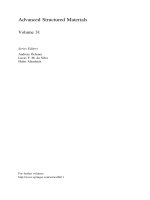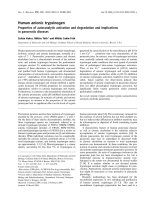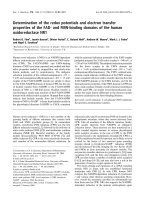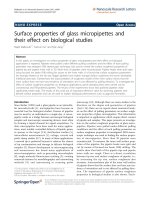Optical limiting properties of GO PVA and AU AG PMMA free standing films
Bạn đang xem bản rút gọn của tài liệu. Xem và tải ngay bản đầy đủ của tài liệu tại đây (816.83 KB, 48 trang )
OPTICAL LIMITING PROPERTIES OF GO-PVA AND
AU/AG-PMMA FREE STANDING FILMS
MA RIZHAO
(B.SC, Fudan University, China)
A THESIS SUBMITTED
FOR THE DEGREE OF MASTER OF SCIENCE
DEPARTMENT OF CHEMISTRY
NATIONAL UNIVERSITY OF SINGAPORE
2014
Declaration
I hereby declare that this thesis is my original work and it has been written by me in
its entirety, under the supervision of Xu-Qinghua, (in the laboratory of Ultrafast
Spectroscopy), Chemistry Department, National University of Singapore, between
Jan.2012 and May.2014.
I have duly acknowledged all the sources of information which have been used in the
thesis.
This thesis has also not been submitted for any degree in any university previously.
i
ACKNOWLEDGEMENTS
I express sincere gratitude to my supervisor, Professor Xu Qing-Hua for his helpful
advice and guidance. My senior, Ms. Jiang Xiaofang, Mr. Gao Nengyue and Mr.
Polavarapu Lakshminarayana contributed a lot to this thesis. I am also grateful to all
the members of Ultrafast Spectroscopy for their kind support and assistance.
I am also thankful to the Department of Chemistry, NUS and all staff for providing
me an opportunity to study here.
ii
CONTENTS
THESIS DECLARATION...........................................................................................i
ACKNOWLEDGEMENTS.........................................................................................ii
TABLE OF CONTENTS............................................................................................iii
SUMMARY...................................................................................................................v
LIST OF TABLES ......................................................................................................vi
LIST OF FIGURES…………………………………………………………………vii
1. INTRODUCTION
1.1 Optical limiting and optical limiting materials
1
1
1.1.1
Optical limiting
1
1.1.2
Graphene oxide with PVA matirx
2
1.1.3
Noble metal nanoparticles
5
1.1.4
Saturable Absorption and Reverse Saturable Absorption
6
1.2 Experimental techniques
10
1.2.1
Open-aperture Z-scan measurement
10
1.2.2
Pump-probe measurement
11
1.3 Overview of this thesis
13
2. HIGHLY EFFICIENT FLEXIBLE BROADBAND NONLINEAR OPTICAL
DEVICES BASED ON GRAPHENE OXIDE IMPREGNATED POLYMER
GLASS
15
2.1 Chemicals and Materials
15
2.2 Preparation of graphene oxide impregnated polymer glass materials
15
iii
2.3 Instrumentation
16
2.4 Result and Discussion
17
2.5 Summary
24
3. THE FREE STANDING FILMS OF NOBLE METAL NANOPARTICLES
WITH PMMA
25
3.1 Chemicals and Materials
25
3.2 Preparation of free standing films of noble metal nanoparticles with
PMMA
25
3.3 Instrumentation
26
3.4 Result and Discussion
27
3.5 Summary
34
4. CONCLUSION
35
5. REFERENCES
36
6. APPENDICES
38
iv
SUMMARY
The development of low-cost flexible broadband optical limiting materials is vital for
the fabrication of eye and optical sensors protection devices from intense
light-induced damage. Here, we presented a simple method for the fabrication of two
kinds of flexible optical limiting devices (GO-PVA free standing film and Noble
metal nanoparticle-PMMA free standing film) by solution process. The linear and
nonlinear optical properties of these prepared flexible films could be controlled by
simply varying the concentration of optical limiting materials in the polymer film.
The optical limiting activity at 400 nm and 800 nm femtosecond laser pulses have
been investigated and it was found that they exhibit highly efficient optical limiting
activity with very low limiting thresholds. Femtosecond pump-probe spectroscopy
measurements performed on these films and reveal that the nonlinear absorption
responsible for the observed optical limiting activity. Furthermore, the amazing
stability and flexibility of these films open a door for the practical applications.
v
LIST OF TABLES
Table 1 The optical limiting onsets (Fon, the input fluency when the transmittance
starts decreasing) and optical limiting thresholds (F50, the incident fluence at which
the transmittance falls to 50% of linear transmittance) of GO-PVA films with
21
different GO concentrations
vi
LIST OF FIGURES
Figure 1 Schematic representation of the behavior of an ideal optical limiter.
2
Figure 2 Energy level diagram for reverse saturable absorption (RSA) process.
10
Figure 3 Experimental Setup of the Z-scan measurement. D1 and D2: photodiodes.
11
Figure 4 Experimental setup of the pump-probe experiment.
13
Figure 5 Schematic of preparing GO free-standing films. (PVA = Polyvinyl alcohol)
16
Figure 6 Raman spectra and UV-vis-NIR transmittance spectra of flexible GO-PVA
17
films in different weight ratios.
Figure 7 Z-scan results of sample weight ratio GO:PVA=0.0025:1 at 400 nm and 800
nm excitations and Z-scan data on different weight ratio samples with same thickness
(480μm ).
19
Figure 8 Pump-probe result of the GO-PVA film (weight ratio=0.0025).
22
vii
Figure 9 Comparison of in situ reduction GO-PVA films.
23
Figure 10 Preparation processes of Au/Ag-PMMA films
26
Figure 11 TEM images of silver nanoparticles and gold nanoparticles.
27
Figure 12 UV-vis. Spectra of Au/Ag-PMMA films in different weight ratios; pure
PMMA; AuNP solution and AgNP solution
28
Figure 13 Open-aperture Z-scan measurements of Au-PMMA (A) and Ag-PMMA (B)
films (Weight ratio=0.001).
29
Figure 14 Z-scan measurement results of Ag-PMMA film (weight ratio=0.001).
31
Figure 15 Fin Vs Trans curve on Ag in PMMA (weight ratio=0.0004)
33
Figure 16 Pump-probe result of the Ag-PMMA film (weight ratio=0.001).
34
viii
1.
INTRODUCTION
This chapter gives a general overview of nonlinear optical materials and their
properties at the beginning to provide a framework for my research work in this thesis,
followed by an introduction of relevant experimental techniques used in this thesis.
1.1. Optical limiting and optical limiting materials
1.1.1 Optical limiting
The advances in the development of lasers have led to revolutionary changes and
applications of lasers in various technological and science applications. The ultra short
light pulses from nanosecond, picosecond and femtosecond laser sources can easily
cause very high power density. High-powered pulsed lasers have found many
applications in academic research as well as in many industrial and military
applications like laser weapons. With the advent of such high power laser sources
operating over wide ranges of wavelengths and pulse durations, the necessity for
protection of sensors, optical components and human eyes from laser inflicted damages
has increased enormously over the last few years1. Under this context, Optical limiters
become important because they can decrease the power density of laser fluence or
irradiance. Fast response optical limiting materials with low thresholds can be used for
protection of eyes and sensitive optical devices from laser-induced damage.Significant
1
research efforts have been devoted for the development of broadband optical limiting
materials and related devices over the past decade. In an ideal optical limiter, the
transmittance change abruptly at some critical input intensity or threshold and therefore
exhibits an inverse dependence on the intensity; the output is thus clamped at a certain
value (Figure 1). If this value is below the minimum that can damage the particular
equipment, the optical limiter becomes an efficient safety device. The effective
optical limiting materials should have low limiting threshold and high optical
damage threshold and stability, leading to a large dynamic range, sensitive broadband
response to long and short pulses, fast response time, and high lineartransmittance,
optical clarity, and robustness2. Researchers have observed effective optical limiting
behavior in various nanomaterials such as carbon nanotube (CNT)
3,4
fullerenes5,
quantum dots6 and metal nanoparticles (Au & Ag)7,8. Recently it has been found that
suspensions of graphene9,10, graphene oxide11,12 and their composites with other
materials13-17exhibit broadband optical limiting properties.
2
Figure 1: Schematic representation of the behavior of an ideal optical limiter.
1.1.2 Graphene oxide with PVA matirx
Most of the reported optical limiting studies on various nanomaterials were performed
where they were dispersed in different solvents and they attributed the optical limiting
due to solvent micro bubbles-induced nonlinear scattering at higher intensities1,3,5,
however, they might show strong saturable absorption when made into thin films 8,18.
For instance dispersions of metal nanoparticles5,6, graphene and graphene-polymer
composites19,20,21 shows strong broadband optical limiting properties, whereas, thin
films of such materials exhibit strong saturable absorption behavior8,16,17,22. Based on
the research work that has been performed so far on optical limiting of various
nanomaterials concludes that nonlinear scattering and nonlinear absorption are the
mechanisms responsible for optical limiting3,6,9. One of the future challenges ahead of
researchers is the fabrication of stable and flexible thin films based optical limiting
devices for real-world applications based on the previous knowledge. Flexible
materials that exhibit high broadband nonlinear absorption are of ideal choice towards
this field of research. Recently, Lim et al.14 reported giant broadband nonlinear
optical response for nanosecond laser pulses on functionalized graphene oxide
nanosheets dispersion. Very recently, our group has shown that spin coated graphene
oxide thin films on glass or plastic substrates exhibit tunable broadband optical
limiting response for femtosecond laser pulses and moreover, the nonlinear optical
3
response of graphene oxide could be tuned from nonlinear absorption to saturable
absorption by reduction of graphene oxide23. From the previous studies it is clear that
graphene oxide could be an interesting material for the development of flexible
optical limiting devices in spite the fact that graphene oxide sheets are easy to prepare
in large scale, highly flexible and highly soluble in various solvents. Herein, we
demonstrate a simple method for the fabrication of flexible nonlinear optical devices
by impregnating graphene oxide into PVA polymer matrix by solution process. The
prepared GO-PVA films have been characterized by UV-visible transmittance,
fluorescence spectroscopy and microscopy techniques. Broadband optical limiting
properties of as prepared flexible GO-PVA films made of different GO/PVA ratios
have been investigated by femtosecond Z-scan measurements at laser wavelengths of
400 and 800 nm. We have found that the flexible GO-PVA films exhibit excellent
optical limiting properties. Femtosecond pump-probe results suggests that nonlinear
absorption (Excited state absorption or multi-photon absorption) of GO play an
important role in the observed strong optical limiting activity. Previous studies
revealed that GO sheets contain sp3 domains and sp2 domains. With the increasing of
sp2 domains, the nonradiative recombination also increased.24 Furthermore, because
of the complex energy band structures, GO films display very strong two-photon
absorption coefficient at 400 nm and strong two- and three-photon absorption at 800
nm, which make them excellent candidates for broadband optical-limiting materials
for femtosecond laser pulses. 23
4
Graphene is one of the crystalline forms of carbon, carbon atoms in graphene are
arranged in a regular hexagonal pattern. Intrinsic graphene is a kind of semi-metal or
zero-gap semiconductor due to the linear energy dispersion relation24,25. Since
graphene has been isolated from graphite by mechanical exfoliation first time in
200426, the studies on graphene was burst out because their potential in technological
applications for optoelectronics and also for a fundamental scientific understanding of
their surprising optical and electronic properties23.
Several methods have been developed to prepare graphene such as chemical vapor
deposition (CVD)27, physical exfoliation24, epitaxial growth28, solvent assisted
exfoliation29,30, longitudinal “unzipping” of carbon nanotubes(CNTs)31 and reduction
of graphene derivatives32-35. Among all these method, the use of graphene oxide(GO)
as a precursor for graphene production offer a route towards solution processed
applications owing to the high solubility of GO compared to graphene in various
solvents33. GO can be easily converted into reduced graphene oxide (RGO) which is a
kind of semiconductor or graphene-like semi-metal by reduction31.
As a result of the unique properties and potential applications of GO-based materials,
numerous studies have been made in this field. However, research toward the
mechanism and application has just begun. Many challenges and opportunities are
still remaining.
5
1.1.3 Noble metal nanoparticles
Noble metal nanoparticles represent an intriguing class of materials due to their
fascinating optical properties arising from their surface plasmon resonances (SPR).
But so far, there are only a few reports on the optical limiting properties of gold and
silver nanoparticles like Goodson et al.36 reported a strong optical limiting ability in
metal-dendrimer nanocomposites with the nanosecond laser pulses. Philip et al.37
reported optical limiting effects in monolayer protected gold nanoparticles with
picoseconds laser pulses. Our group also reported the optical limiting properties of
oleylamine-capped gold nanoparticles for both femtosecond and nanosecond laser
pulses. From previous reports, the optical limiting properties of metal nanoparticles
depend on their size, shape and surrounding environment like polymer matrix or
solvent38,39. Francois et al.40 observed that the threshold of the optical limiting effect
decreased with increasing particle size when they studied the optical limiting behavior
of gold nanoparticles at 530 nm using picoseconds laser pulses. They suggested this
behavior was responsible for nonlinear scattering. Wang and Sun41 found that
aggregated gold nanoparticles showed strong optical limiting properties even though
individual gold nanoparticles exhibited no optical limiting behavior. From these
previous reports,38,39,40,41 the mechanism can be summarized that when the noble
metal nanoparticles excited by medium power laser pulses, the energy transfer from
the excited nanoparticles to the solvent generates solvent bubbles that scatter light.
With high power laser the metal particle itself will expand by melting/vaporization of
6
surface atoms and the expanded particles act as another type of scattering center and
limit the light transmission during the laser pulse duration.
In this work, we have prepared oleylamine-capped gold/silver nanoparticles in
Dichloromethane (DCM) and incorporate them into PMMA solution to fabricate free
standing films and studied the optical limiting properties of these films. The optical
limiting properties of oleylamine-capped gold nanoparticles were studied by our
group previously and these nanoparticles show strong broad band optical limiting
effects for nanosecond laser pulses at 532 and 1064 nm and femtosecond laser pulses
at 780 nm.6
1.1.4 Saturable Absorption and Reverse Saturable Absorption
Saturable absorption is a third order nonlinear optical process happening in materials
which exhibit a decrease in light absorption with increasing light intensity. The
electrons in the ground state of a saturable absorber are excited into an upper energy
state at a rate that is faster than their subsequent relaxation back to the ground state
when the incident light intensity is high enough42. This leads to a depletion of
electrons in the ground state, also known as ground state bleaching, and is
experimentally exposed as a rise in transmittance.
Saturable absorption has applied in passive mode-locking and Q switching of lasers
7
for the generation of short laser pulses43. The saturable absorbers are also used for
nonlinear filtering to clean up pulse shapes and to process optical signals. Recently,
saturable absorption has been exhibited as a means for information storages44 which
opens a broad application space. There are many types of saturable absorbers like
semiconductor saturable absorber mirrors, PbS quantum dots, GaAs and Cr4+:YAG
crystals which widely used in lasers.
The absorption cross-sections of saturable absorbers in excited state are usually
smaller than in ground state. If the absorption cross-section in excited state larger than
in ground state, the material will be less transmissive with increasing light intensities.
This phenomenon is called as reverse saturable absorption, because it is an opposite
effect of saturable absorption. RSA can be caused by several nonlinear optical
processes including multi-photon absorption, excited state absorption, nonlinear
scattering and free carrier absorption45.
The multi-photon absorption commonly observed from semiconductor quantum dots,
organic dyes and noble metal nanostructures under the irradiation by a laser pulse.
Recently, graphene and graphene oxide have been reported as good multi-photon
absorption materials also. The process of multi-photon absorption can be sequential or
instantaneous, depending on the system. Excited state absorption happens when an
excited state is significantly populated as a consequence of intense excitation. Ground
state electrons are promoted to an excited state when excitation happens and in
8
excited state the electrons only remain for a short period of time. The excited state
electrons can be excited to a higher energy level, decay back to the original ground
state or undergo intersystem crossing to a different spin state. The performance of
excited state absorption is similar to the sequential absorption of multi-photon
absorption.
Nonlinear scattering is normally observed from materials with large scattering cross
sections, of which noble metal nanocrystals are good nonlinear scattering material46.
The noble metal nanocrystals can either absorb or scatter the light when they are
excited by light. From previous reports, the size is important to the scattering cross
sections of the noble metal nanocrystals, larger metal nanocrystals are more efficient
at scattering light than smaller ones47. This nonlinear scattering phenomenon also
leads to a decreased transmittance which corresponding to reverse saturable
absorption.
Free carrier absorption occurs when electrons are promoted to the conduction band
when excited by photons with energy greater than the band of material 48, these
electrons turn into free carriers in the conduction band. These free carriers can absorb
more photons when irradiated by high enough intensity lasers, which lead to nonlinear
absorption.
Both SA and RSA are normally associated with the third order nonlinearity of
9
materials. Materials like graphene and graphene oxide have been reported as RSA
materials before. Noble metal nanoparticles have been shown to demonstrate both SA
and RSA at various excitation fluencies, acting like optical switches. At low
excitation fluencies, SA dominates due to ground state bleaching of the surface
plasmons in noble metal nanoparticles, but with the increasing laser power, RSA
becomes more dominant because the nonlinear absorption and scattering processes
play increasingly significant roles.
Figure 2: Energy level diagram for reverse saturable absorption (RSA) process.
1.2 Experimental techniques
1.2.1 Open-aperture Z-scan measurement
The Z-scan measurement is a technique for measuring degenerate nonlinearities
10
presented by M.Sheik-Bahae et al. at 199049. The nonlinear absorption coefficient of
nonlinear materials can be determined from an open-aperture z-scan experiment. The
saturation irradiance can also be determined from the open-aperture Z-scan
experiment if saturable absorption happens.
Excitation source of this system is a Spectra-Physics Ti:sapphire amplifier laser
system. The laser output has a central wavelength of 800 nm and pulse duration of
~100 fs at a repetition rate of 1 kHz. The laser pulses are focused onto the sample by
using a lens with a focal length of 15 cm, giving a focal spot size of ~40 μm (radius).
In a z-scan measurement, the transmittance of the sample is measured as the sample is
moved towards and away from the beam focus. By collecting all the transmitted
energy, information on nonlinear optical absorption will be obtained. The z-scan
experiment setup is tested by measuring the third-order nonlinear absorption
coefficient of a standard sample (bulk ZnSe). Because of the simplicity, accuracy and
sensitivity, the open-aperture Z-scan measurement is now a popular technique to
characterize optical limiting and saturable absorption of the nonlinear optical
materials. The experiment setup of the Z-scan measurement shows below in Figure 3.
11
Figure 3: Experimental Setup of the Z-scan measurement. D1 and D2: photodiodes.
1.2.2 Pump-probe measurements
The electronic relaxation of nonlinear materials can be measured by using
femtosecond pump-probe spectroscopy. The transient absorption (TA) and single
wavelength dynamics of nonlinear materials can be obtained from pump-probe
measurements also. The TA spectra provide an insight on the behavior of excited
electrons as a function of time over a range of wavelengths probed. On the other hand,
single wavelength dynamics measurements allow one to study the electronic
relaxation rates at the specific wavelength probed by fitting the time-resolved decay
curves obtained.
A typical optical set up for a pump-probe experiment using a Spectra-Physics
femtosecond Ti:sapphire laser system is as shown in figure 4. The amplifier laser
system gives output pulse energy of 2 mJ at 800 nm with a repetition rate of 1 kHz.
The 800 nm laser beam is split into two portions. The larger portion of the 800 nm
12
beam passed through a BBO crystal for the generation of 400 nm pump beam by
second harmonic generation. The smaller portion of the laser beam is used to generate
white light continuum in a 1 mm sapphire plate. The white light beam is further split
into two portions, one as the probe and another as the reference to correct
pulse-to-pulse intensity fluctuations. The pump beam is focused onto the sample with
a beam size of 300 μm and overlaps the smaller probe beam (100 μm in diameter).
The delay between the pump and probe pulses is varied by a computer-controlled
translation stage (Newport, ESP 300).
Figure 4: Experimental setup of the pump-probe experiment.
Pump-probe experiments are carried out at room temperature and the pump and probe
beams are keeping low energies to minimize photodamage to the samples. In a
pump-probe scan, the value of the normalized pump-induced absorption change (ln
(T/T0)) is determined as a function of the delay time between the pump and probe
pulses. The transient absorption spectra at different delay times are measured by
13
passing the probe beam through a monochromator before a photodiode detector that is
connected to the lock-in amplifier.
1.3 Overview of this thesis
In this M.sc. thesis, the study of two kinds of nonlinear optical material will be
presented. We have found a very simple way for the fabrication of flexible free
standing nonlinear optical devices by impregnating graphene oxide into PVA polymer
matrix and noble metal nanoparticle into PMMA polymer matrix by solution process.
The prepared flexible free standing films have been characterized by UV-visible
transmittance, fluorescence spectroscopy and microscopy techniques. Broadband
optical limiting properties of different GO/PVA ratios ratios have been investigated
by femtosecond Z-scan measurements at laser wavelengths of 400 and 800 nm. We
have found that these flexible free standing films exhibit excellent optical limiting
properties. Femtosecond pump-probe results suggest that nonlinear absorption
(Excited state absorption or multi-photon absorption) of GO play an important role in
the observed strong optical limiting activity of GO/PVA films. The optical limiting
properties of Au/Ag-PMMA films are also investigated by femtosecond Z-scan
measurements at laser wavelengths from 600 nm to 1100 nm. They also demonstrate
strong optical limiting ability and the femtosecond pump-probe results suggest the
optical limiting can be attributed to the nonlinear absorption. Furthermore, lattice
matrix is used to improve the optical limiting ability of Au/Ag-PMMA films.
14
2
HIGHLY EFFICIENT FLEXIBLE BROADBAND NONLINEAR
OPTICAL DEVICES BASED ON GRAPHENE OXIDE IMPREGNATED
POLYMER GLASS
2.1 Chemicals and Materials
Graphite flakes (Asbury Carbons Ltd.), NaNO3, KMnO4, H2SO4, HCl, H2O2 (30%)
and polyvinyl alcohol (PVA, molecular weight 10000) were purchased from Sigma
Aldrich. All solvents are of analytical grade and used as received without further
purification. All aqueous solutions are prepared in deionized water.
2.2 Preparation of graphene oxide impregnated polymer glass
GO was prepared from graphite via a modified Hummers and Offeman method33. The
gained GO was further purified by washing with ethanol and water for multiple times
and then completely dried by using a rotary evaporator. The dried GO was dispersed
in water for preservation. Free-standing GO thin films can be fabricated by
incorporating GO into polyvinyl alcohol (PVA) polymer matrix. PVA was added to
deionized water to a concentration of 200 mg·mL-1. The solution was mixed and
heated overnight at 80 °C to dissolve the PVA. Next, GO sheets were dispersed in
deionized water to a concentration of 0.5 mg·mL-1.
15
In order to fabricate GO-PVA films of different weight ratio, 1 mL, 2 mL, 4 mL and
10 mL of 0.5 mg·mL-1 GO solution was added to 10 mL of 200 mg·mL-1 in 4 different
glass tubes respectively. The mixture in the 4 tubes was shaken to ensure
homogeneity before transferring into 4 different petri dishes (Figure 3a). The petri
dishes were dried by heating at 40 °C overnight. The free-standing GO-PVA thin
films were then peeled off and collected. The thickness of the GO-PVA films was
measured using micrometer caliper and found to be 480 μm. Figure 5 below
demonstrates the preparation process of GO free-standing film (weight
ratio=0.00025).
1μm
PVA
200mg/mL
GO
0.5mg/mL
mix
Pour into
Dry at 40℃
petri dish
12 hours
Figure 5: Schematic of preparing GO free-standing films. (PVA = Polyvinyl alcohol)
2.3 Instrumentation
16









